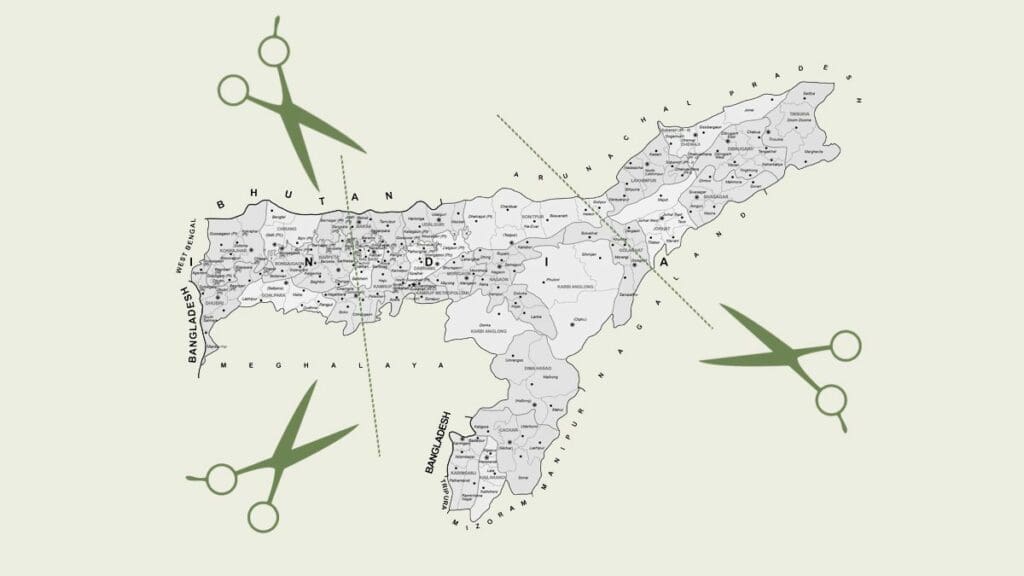
The nomenclature of existing Naoboicha assembly constituency in Assam’s Lakhimpur district has been its mix of voters in such a way that no community could play a decisive role. It has had both Hindu and Muslim candidates elected to the state assembly since the seat was unreserved in 1978. But the draft delimitation published by Election Commission of India on 20 June has invariably seem to have jeopardised the arrangement.
The constituency, according to the draft electoral role of 2023 published on 9 November 2022 by the ECI, has a total of 2,34,815 voters constituting tribes, caste Hindus and significant Muslim electorates. But the new draft has been a point of contention as the ECI has divided the constituency four parts, adding and removing various areas. Local political parties and previous candidates have accused such division and addition confusing as well as flouting ECI’s own guidelines and methodology.
Especially, the fate of minority Muslim candidates have been reduced to almost unelectable in the constituency; though it had elected a Muslim candidate four times since 1978. All the previously successful Muslim candidates are no more part of the proposed new Naoboicha constituency.
Prior to 1978, the constituency was reserved for SC candidates only.
Noiboicha assembly constituency was formed in 1967 following the nationwide delimitation practice as per the Delimitation Commission Act 1962.However, the assembly constituency was earmarked for SC reservation.
But in 1976 after the reorganization of constituencies which was implemented in 1978, Noiboicha was categorized to unreserved seat because of not having mandated SC population within the boundary of the constituency.
Since then, three Muslims — Afaz Udding Ahmed in 1978 and in 1983, Sultan Sadik in 2001 and Mamun Imdadadul Haque Chawdhury in 2016— won the assembly seat. When the Muslim candidates did not win, the minority contestant remained a runner up.
In a social media post on the draft delimitation of Naoboicha seat, former MLA of Naoboicha, Chawdhury wrote “…out of the all local (former) MLAs who were elected from Naoiboicha Constituency, the houses of Afaz Uddin Ahmed, Sultan Sadik and this writer (himself) now fall under the Bihpuria constituency” adding that none of the previous MLAs’ houses have remained within the Naoboicha constituency.
Lakhimpur district which is around 375 km away from Guwahati and situated on the North bank of the Brahmputra, has four assembly constituencies currently. But the draft proposal increases the seats to five. This increase has triggered anxiety among people as well as aspiring Muslim candidates from the constituency.
Former All Assam Minority Students’ Union (AAMSU) adviser and general secretary of Akhil Gogoi-led Raijor Dal (Peoples’ Party), Azizur Rahman, said, “the ECI has violated its own rules. As per the section 4, 5 and 6 of the Guidelines and Methodology, Lakhimpur should have four seats. But flouting this, the ECI has formed five seats and to accommodate the new constituency, it has divided Naobiocha in four parts.”
The ECI has categorized all districts in A, B and C categories according to the population density as per the 2001 census.
“A- Districts having population density less than 304 persons per sq. km.; B- Districts having population density between 304 to 372 persons per sq. km.; C- Districts having population density more than 372 persons per sq. km,” the ECI, in its methodology, said. So, for A category district, seats have been decided by deducting 10 percent from the state average population and for C Category districts, the ECI has added 10 percent to the state average population while finalizing the number of seats in each category districts.
The average population number for each constituency was fixed at 1,90,397 for A Category districts, 2,11,552 (state average assembly constituency population) for B Category districts and 2,32,707 for C category districts.
“According to the 2001 census data, the total population of Lakhimpur was 8,89,010 people and had a density of 390 persons. So, it is a C-category district. And if we divide the total population with the average assembly constituency population for C-Category district (2,32,707) then the number is 3.82, which is considered four. So, the number of seats should have remained 4. But the ECI flouted its own guidelines and created five constituencies. Moreover, it also organized Naoboicha constituency bringing in Mishing tribal areas, distant villages from either side of Ranganadi and areas adjacent to Subansiri river. Not only that, the ECI has it reserved for SC irking Mishing tribals”, said Azizur.
While the minority politicians assert that they knocked every door to maintain the geographical compactness of Naoboicha constituency, the “ECI has been inattentive even to the objections during the public hearings in Guwahati on the delimitation practice.”
“This proved that the ECI has taken the side of the BJP and CM Himanta Biswa Sarma and arbitrarily carrying out the delimitation of Assam” claimed Azizur who was the runner up in the 2021 assembly by a margin of around 3000 votes.
“When I tried to rationally reason the Election Commission body, not only they were using mobile phones to not listen to the public opinion, they arbitrarily had me removed from the hall for raising my concerns,” said Azizur, adding that he is preparing to submit a petition in the Supreme Court of India about the “dubious public hearing.”
The ECI’s draft delimitation has been accused of being communal and it also hampers the prospects of Muslim representation in the state assembly as many minority dominated seats have either been done away with or have been reserved for SC or ST candidates.



